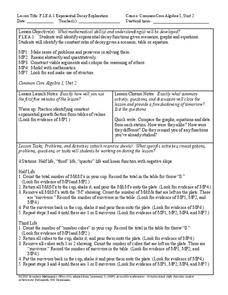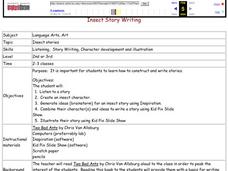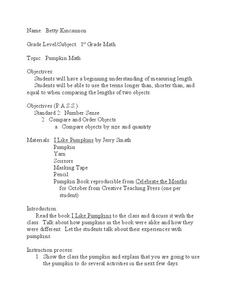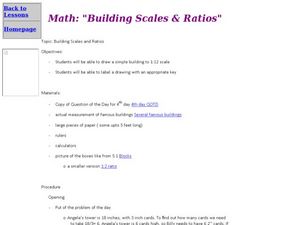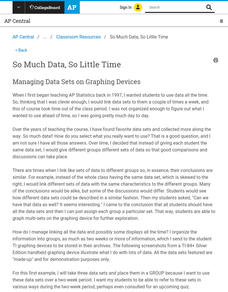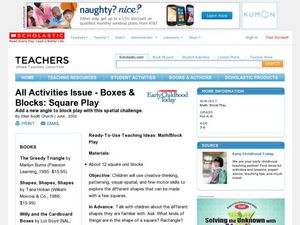Curated OER
Birds' Eggs
More than just data, scatter plots are full of information that can be used to answer a variety of questions. This lesson uses a plot with information about bird egg sizes to answer questions about the relationship between length and...
Howard County Schools
Exponential Decay Exploration
How can you model exponential decay? Explore different situations involving exponential decay functions and decreasing linear functions by performing activities with MandM candy, popcorn kernels, and number cubes.
Curated OER
Math: Perimeter, Area, and Volume
Eighth graders discover how to compute the perimeter, area, and volume of different objects. With partners, they find and calculate the perimeter , area, and volume of 10 items each and exchange information. Students compile their...
Curated OER
Math: Odd Object Out
Students discover how to classify and categorize items by sorting various objects. As they sort the items, they explain how the items are alike. By repeating the sorting procedure several times, students determine there are numerous...
Curated OER
Pumpkin Math
Learners discover how to measure the circumference of objects. In this measurement lesson, students use a pumpkin and a tape measure to estimate and find the circumference of the pumpkin.
Curated OER
Getting to Know You
Students converse with each other while playing a game in order to discover things that are alike and things that are different about themselves. The students gather data about themselves, organize and display data on the graph, and...
Curated OER
Spirals
In this secondary mathematics worksheet, students determine if the two given spiral drawings are alike or different. The one page worksheet contains one problem with the solution.
EngageNY
Solving Percent Problems
Don't discount how much your pupils understand percents! The 27th lesson in a series of 29 presents a problem to find the cost of a discounted outfit. Small groups determine either the original price or the discount received given the...
Curated OER
Junk Sort
Students analyze objects by one or more attributes. In this sorting instructional activity, students use manipulatives and string or yarn to create a sorting game. Students read books and items from the classroom to sort.
Curated OER
How Many Are There?
This is a very basic instructional activity intended to provide practice in solving word problems involving subtraction. Learners read the word problems then subtract to find the answer. An answer key is included.
Curated OER
Color and Compare: Venn Diagram
In this color and compare worksheet, students will color two different snowmen and use a Venn diagram to compare and contrast their similarities and differences.
Curated OER
Property Lists for Quadrilaterals
Learners establish classifications of shapes by various properties (angles, sides, etc.). They introduce the important properties of common shapes. Students develop an awareness of the wide variety of ways the 2-D shapes can be alike.
Curated OER
Building Scales and Ratios
Students solve problems using scales and ratios. In this algebra lesson plan, students create drawings using scales of 1:12. They follow a key to help them draw different buildings using the right scales. They also complete word problems...
College Board
So Much Data, So Little Time
Organizing data in a statistics class is often a challenge. A veteran statistics teacher shares data organization tips in a lesson resource. The instructor shows how to group data to link to individual calculators in a more efficient...
Howard County Schools
Factoring Trinomials Using Tiles
What's the opposite of multiplying binomials? Learners apply their previous knowledge of multiplying binomials using algebra tiles to factor trinomials. The activity introduces factoring as a process that uses algebra tiles to...
Georgetown University
Cup-Activity: Writing Equations From Data
Determine how cup stacking relates to linear equations. Pupils stack cups and record the heights. Using the data collected, learners develop a linear equation that models the height. The scholars then interpret the slope and the...
CK-12 Foundation
Whole Number Subtraction: Penguins Go for a Swim
As penguins jump off of an iceberg, young mathematicians count the remaining penguins in order to discover the whole number subtraction answer. As they work through the questions, they can manipulate the red dot to add and subtract more...
Curated OER
Shoeless Math
First graders sort and classify, and complete a T-chart using Students' shoes.
Curated OER
Boxes & Blocks: Square Play
Students add a new angle to block play with this spatial challenge. In this early childhood math instructional activity, students use creative-thinking, patterning, visual-spatial, and fine-motor skills to explore the different shapes...
Curated OER
Activity Plan 5-6: Book-Character Homes
Students use their creativity to build character homes. In this early childhood lesson plan, students develop creative-thinking, social, language, math, and motor skills as they work together to create buildings for characters from...
Curated OER
Shapes
Students identify attributes of different geometric shapes. In this geometry lesson, students view a PowerPoint presentation on shapes and use attribute blocks to examine the corners and edges of each shape. Students work together...
Curated OER
Money
Students count money using only coins. For this money lesson, students read Bennies Pennies, practice counting the pennies in the story and are then introduces to the different coins, penny, nickel, dime and quarter. Students...
Curated OER
Seed Sorting 101
Students sort through numerous seeds to find similarities and differences. In this sorting and classifying lesson, students divide up different plant seeds based on their similarities and differences, while keeping record of their findings.
Perkins School for the Blind
Coin Identification
You got some money, and you're not afraid to use it. Before you can use that money, you need to know what it's worth. Included is a set of activity instructions that will help your visually impaired learners indentify coins. Pupils...



